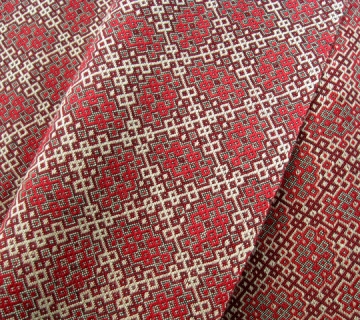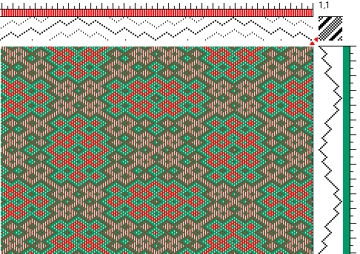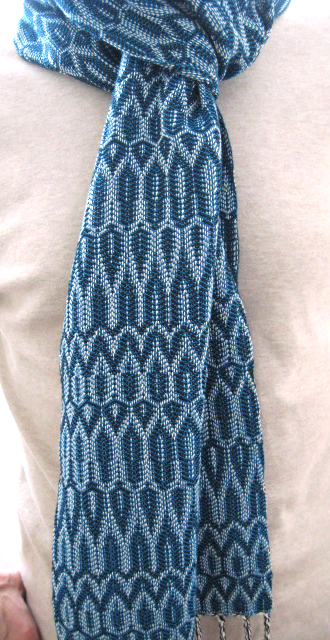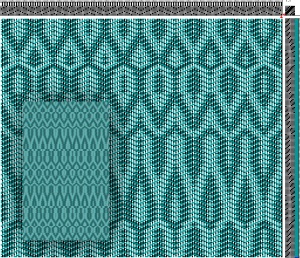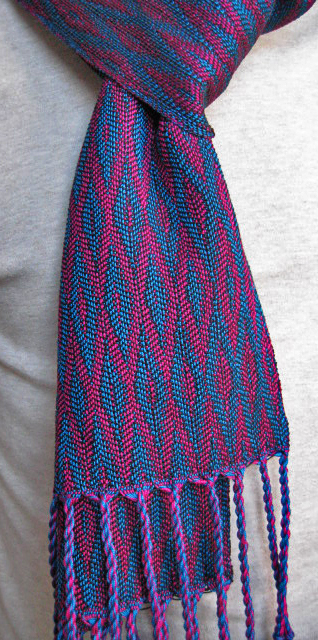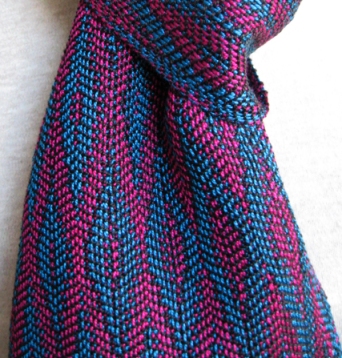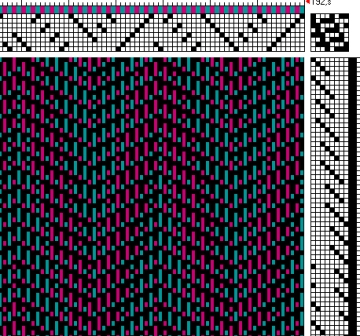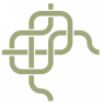In this post I’m pleased to share the contents of my article, “Gebrochene to Echo,” that was published in the October, 2012 (the 100th issue!), of the Complex Weavers Journal. It is about my study for this year’s woven sample exchange of the Fine Threads Study Group at Complex Weavers. It’s such a thrill each year when the samples arrive in the mail because each weaver’s work is unique and beautiful.
In my article I mention Marjie Thompson, a member of my study group and someone who is knowledgeable about pre-20th century weaving. I would like to add here that Marjie wrote a fascinating article about Gebrochene twills, “The Earl’s Canvass,” that appeared in Weaver’s Magazine (Winter 1997, issue #38) that is also included in the chapter on plain and fancy twills in Twill Thrills (The Best of Weavers), edited by Madelyn van der Hoogt. She notes that Gebrochene is the German term for what today’s weavers sometimes refer to as M’s and W’s, and that these elaborate twills seen in tablecloths have been found in medieval art and in drafts in manuscripts and books from the early 17th century.
On a personal note, in case I don’t post again before the end of this year, I would like to wish an early Season’s Greetings and a happy and healthy New Year to weavers, followers, and all visitors to my blog!
You can view the photo and download the WIF file from the Complex Weavers website by clicking here.
Complex Weavers Journal, October 2012, issue #100
Gebrochene to Echo
by Eva Stossel
Fine Threads Study Group
A few years ago I designed a shadow weave pattern with parallel threading. Going beyond the mostly plain weave structure of shadow weave, I recently wove my first pattern with a recognizable “echo,” also designed with parallel threading and wanted to learn more.
The woven samples for this year’s Fine Threads study started out as a 16-shaft pattern I designed with a threading of jagged looking M’s/W’s, tromp-as-writ treadling, and solid colors in warp and weft. The drawdown reminded me of something I have seen before – Gebrochene, but wasn’t sure if that’s what it was. I consulted Marjie Thompson who is knowledgeable about pre-20th century weaving and happens to be in our study group, and she confirmed that in fact it is Gebrochene of four divisions and that she has seen drafts of four divisions in only one manuscript (see Draft 1).
I really liked the pattern but wanted to experiment with it. Using Fiberworks PCW, the 1/3/1/1/1/1/1/1/1/3/2 twill tie-up was “cycled” and transformed to 1/1/1/1/3/3/3/1/1/1/. Then, when the threading was redrawn as an extended parallel repeat with alternating colors, a surprisingly delightful pattern emerged, one with several distinct areas of different colors that still resembled Gebrochene. I showed it to Bonnie Inouye, and she considers it to be an example of Echo (see Draft 2).
As expected, after the pattern was redrawn as an extended parallel repeat it was stretched out horizontally. I chose to compensate for this by varying yarn sizes and sett, keeping in mind that the longest float is five. Using 20/2 rayon as warp and 2/64 silk/merino as weft, I wove a sample at 42 epi and 42 ppi (two strands of weft yarn together) resulting in a flimsy fabric with an overly stretched-out pattern. I wove a second sample at 54 epi and 36 ppi (two strands of weft yarn together), an improvement, but not satisfactory. The third and final sample woven at 72 epi and 42 ppi (only one strand of the 2/64 weft yarn) is the best, structurally as well as the way the colors interact with each other as a result of a close sett, thicker warp and thinner weft. The yardage woven on my 16-shaft workhorse Macomber was hand washed gently, rolled in a towel to remove excess moisture, air dried and steam ironed while slightly damp, with approximately 6% shrinkage in length and 3% in width.
I’m so inspired to go on exploring this vast, parallel weaving universe!
